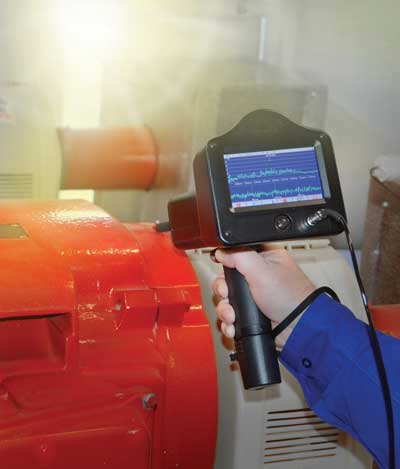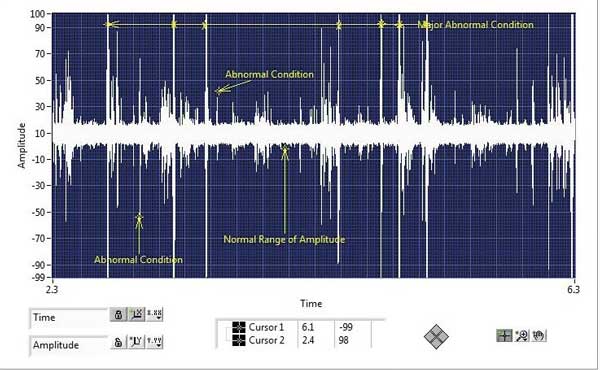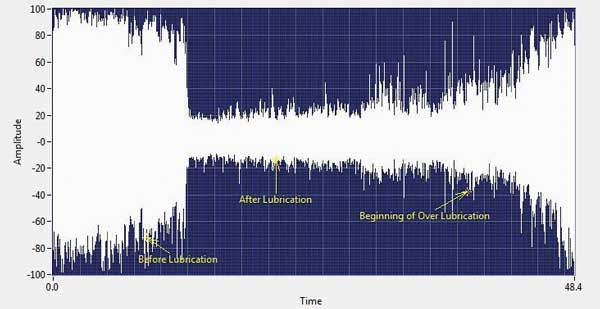 Vibration analysis has long been the instrument of choice to use for bearings and other rotating equipment. Increasingly, ultrasound is being used in conjunction with vibration analysis to help technicians confirm the condition of mechanical assets. Ultrasound is especially useful with applications where vibration normally cannot help, such as condition-based lubrication and the inspection of slow speed bearings.
Vibration analysis has long been the instrument of choice to use for bearings and other rotating equipment. Increasingly, ultrasound is being used in conjunction with vibration analysis to help technicians confirm the condition of mechanical assets. Ultrasound is especially useful with applications where vibration normally cannot help, such as condition-based lubrication and the inspection of slow speed bearings.
How does it work?
Mechanical movements produce a wide spectrum of sound. One of the major contributors to excessive stress in machinery is friction. Ultrasound instruments detect friction. By focusing on a narrow band of high frequencies, an ultrasound instrument detects subtle changes in amplitude and sound quality produced by operating equipment.
It then heterodynes these normally undetectable sounds down into the audible range where they can be heard through headphones and observed on a display panel for trending, comparison, and analysis.
It has been established that ultrasound monitoring provides early warning of bearing failure. Various stages of bearing failure have been established.
- An 8 dB gain over baseline indicates pre-failure or lack of lubrication.
- A 12 dB increase establishes the very beginning of the failure mode.
- A 16 dB gain indicates advanced failure condition
- A 35-50 dB gain warns of catastrophic failure.
Inspecting slow speed bearings
Slow speed bearing monitoring with ultrasound is easier than you might think. Because most high-end ultrasound instruments have a wide sensitivity range and frequency tuning, it is possible to listen to the acoustic quality of the bearing, especially at slower speeds. In extreme slow speed bearing applications (usually less than 25rpm), the bearing will produce little to no ultrasonic noise. In that case, it is important not only to listen to the sound of the bearing, but more importantly to analyse the recorded ultrasound sound file in a spectrum analysis software, focusing on the time waveform to see if there are any anomalies present. If “crackling” or “popping” sounds are present, then there is some indication of a deformity occurring. In bearing speeds above 25rpm, it is possible to set a baseline decibel level and trend the associated decibel level readings over time.

Ultrasound assisted lubrication
Studies have shown that most premature bearing failures can be attributed to poor lubrication practices, whether it’s using the wrong grease for the wrong application, lubricant contamination, over lubrication, or even under lubrication. Ultrasound can be used to prevent over and under lubrication related failures. Additionally, when using ultrasound for bearing lubrication, the move is more towards condition-based lubrication rather than time-based lubrication.

The concept is simple. It’s based on friction. When a bearing is in need of lubrication, there is an increase in amplitude or the decibel level. If a technician is using ultrasound to listen to the bearing while greasing and watching the associated decibel level on the ultrasound instrument, if the bearing needs grease, there will be a gradual drop in the dB down to a more normal or baseline dB. At that point, the technician should stop lubricating. If the bearing is already sufficiently lubricated, the technician would start to see a gradual increase in the dB as grease is added. As more grease is added to an already sufficiently lubricated bearing, there is an increase in both pressure and friction inside the bearing housing and therefore more noise. In this scenario, the technician should stop applying grease when an increase in dB is noted. If the technician is applying grease to a bearing and there is no change in the dB, then a follow-up inspection to record the ultrasound sound file again, or a complementary technology such as vibration analysis should be used to determine why the dB did not change during lubrication. If the bearing has physical damage or is in a failure mode beyond a lack of lubrication, then there will be little to no change in the dB while greasing.
Chris Hallum – UE Systems Europe
Regional Manager UK & Ireland
+44 7930 352 188
chrish@uesystems.com
www.uesystems.co.uk

